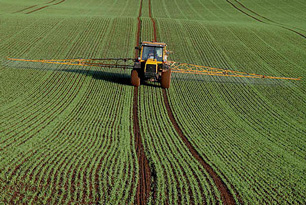Glyphosate [N-(phosphonomethyl)glycine]
| EPA Maximum Contaminant Level (MCL) |
0.7 mg/L |

Glyphosate [N-(phosphonomethyl)glycine] is a widely used herbicide (in fact, it is the most widely used herbicide) for controlling weeds in agriculture, forestry, roadsides, lawns and aquatic areas. It's the active ingredient in Roundup®*, the pervasive herbicide manufactured by the Monsanto biotech company. (Monsanto also bioengineers glyphosate-resistant crops, notably corn and soy.)
Glyphosate arrives in drinking water primarily through agricultural runoff.
Health Effects of Glyphosate
According to the World Health Organization, due to its low toxicity and insignificant concentrations in most water, glyphosate “does not represent a hazard to human health.”
Still, the EPA warns acute exposure can cause symptoms of lung congestion and rapid breathing. The agency also warns that long term exposure can affect the kidneys and reproductive system:
Some people who drink water containing glyphosate well in excess of the maximum contaminant level [0.7 milligrams per Liter (mg/L)] for many years could experience problems with their kidneys or reproductive difficulties.
Water Treatment for Glyphosate
The EPA recommends granular activated carbon (GAC) for the treatment of glyphosate, although Lenntech reports that activated carbon has only a “moderate probability” of removing glyphosate on its own.
*Monsanto has also used the trade names Aquamaster®, Gallup®, Honcho®, Landmaster®, Pondmaster®, Ranger®, Rodeo®, and RT 3, and it's known worldwide by even more names.
Sources: EPA (1), EPA (2), EPA (3), WHO, EXTOXNET, Farm Chemicals International, Lenntech, Photo: geograph.org.uk, author: Walter Baxter
Site Index
Filtration Systems
- Aeration for Iron & Sulfide
- Backwashing Filters
(whole house & well units)
- Chlorine & Chemical Injectors
- Countertop Water Filters
- Garden Hose Filters
- Reverse Osmosis, Residential
- Reverse Osmosis, Commercial
- Shower Filters
- Specialty Filters
- Ultraviolet Systems
- Undersink Filters
- Water Softeners
- Whole House Filters
Cartridges
Parts
- Replacement Parts
- Faucets
- Filter Media
- Fittings
- Housings
- O-rings
- Pumps
- Pura UV
- R.O. Parts
- R.O. Tanks
- R.O. Booster Pump
- VIQUA UV